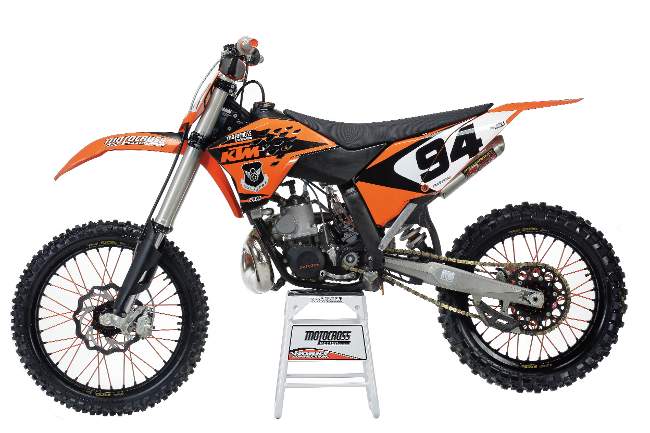TWO-STROKE TEST: WE TURN OUR KTM 250SX INTO A KTM 300SX BIG-BORE

As the niche marketing specialist of dirt bike manufacturers, KTM has a wider variety of models than Baskin-Robbins has flavors. However, the model you won’t see at your KTM dealership is a motocross-specific Open class two-stroke. The KTM 300XC (cross-country) model is close, but ultimately not as good as the 300SX kit for racing.
After spending a couple years holding our own against 450s and blowing the doors off 250Fs on our aged 2010 KTM 250SX, the MXA wrecking crew’s primitive instincts took over, and we decided to hop it up. The problem is that since it makes 49 horsepower in stock trim, we had to do something hardcore to make it fast and rideable.
The answer was right in front of us. KTM makes a bolt-on kit that would slip on any ready-to-go KTM 250SX. This was our chance to take KTM’s well-worn 250SX and make it new. No, make it better than new.

WHAT DO YOU GET FOR THE MONEY?
There are two different versions of 300SX engine kits: An enduro/cross-country version (XC), and a motocross (SX) version. The main difference between the two boils down to slightly different cylinder heads and ignition map boxes. Both include parts for a full top-end replacement. The KTM manufactured kits retail for $799.99. Here is the list of what is included:
Cylinder: The 293cc cylinders are the same for the enduro (EXC-W), cross-country (XC) and motocross (SX) models, and they have had the same porting and specifications since 2009.
Cylinder head: There are two different cylinder heads?a slightly lower compression XC head and a high-compression SX head, which still runs on pump gas.
Piston: Like the cylinder, the flat-top pistons have been the same since 2009. Some tuners feel that the flat-top piston is better at controlling detonation and works much more efficiently with pump gas.
Black box: The XC and SX kits have different maps. The ignition for the SX kit is more aggressive (as you would expect).
Power valve parts: When you increase the bore from 66.4mm to 72mm, you need all-new power valve parts to provide clearance for the big piston.
Base gaskets and O-rings: There are four thicknesses of gaskets for proper tuning and clearance.

In the past, consumers could buy a KTM 300SX at their local dealership, but KTM consolidated that bike into a bolt-on aftermarket kit. If you want a 300cc motocross bike, you have to start with a 250SX and slip on the 300 kit. The KTM kit includes everything you need to up-size the top-end?plus a more aggressive black box.
HOW MUCH WORK WAS INVOLVED?
The 300SX engine kit is a straightforward swap-out of the top-end. You don’t reuse any of the old parts from the 250cc top-end. For a backyard mechanic, the most difficult part of installing the 300 kit would be draining the coolant (which is pretty easy). Anyone with a modicum of mechanical experience can install this kit. It involves nothing more than installing a new piston and sliding the cylinder over it.
KTM engine kits come with four different thicknesses of base gaskets. During installation, you measure the piston at TDC (top-dead center) and use the gaskets to get the piston twenty-thousandths of an inch (0.020) of clearance. Or, if you choose, you can use a thicker or thinner base gasket to manipulate the compression ratio. This can be useful if you plan on running crummy fuel.
WERE THERE ANY SPECIAL NEEDS?
There are a few setup changes to consider. We added an extra tooth on the rear of the 250SX, but went back to stock or taller gearing to mellow the hit and maximize the power of the 300 engine. KTM claims the power valve governor on the 250 engine is more responsive than the governor that comes in the 300XC?there are three springs to modulate its actuation.

It’s old now, but it’s still awesome. MXA’s revived 2010 KTM 300SX kit bike pumps out some serious power. The stock 2010 KTM 250SX was no slouch, but the 293cc engine kit never makes less than one horsepower more than the 250SX at every spot on the curve and, in some very important sections, it makes as much as four horses more. The peak horsepower is an impressive 51.
WHAT WAS IT LIKE TO RIDE?
Our stock 2010 250SX made strong mid-and-up power, but it doesn’t have as much hit as we wanted. Not so with the 300. It hits?hard. If you are like us, you probably thought the 300 kit would produce a torquey, tractor-like powerband. Wrong! The 300SX is an angry 250?not a mini 500. After the brutal midrange (which can easily launch the lightweight big-bore out of turns ahead of 450s), the 300’s power continues to climb. Peak horsepower (51 horsepower) is only up 1.75 horses over the stock 250 engine, but the gains below and above peak are closer to four horsepower more. From 6000 rpm to sign-off the 300 engine produces the same dyno curve as the 250?only beefed up by two to four horses. In the hands of an experienced two-stroke pilot, the 300-kitted KTM was a potent weapon. You have two choices: You can kit your 250SX or opt for a 300XC from the showroom. With the 300XC, you get an 18-inch rear wheel, larger tank, more electronics and mellow powerband. With the 300 kit, you get a serious motocross engine (and if it is too brutal, you can gear it up, change power valve springs or mount a flywheel weight).
For more information, see your local KTM dealer or go to www.ktm.com





Comments are closed.